Jinghui Lu
Vision as LoRA
Mar 26, 2025Abstract:We introduce Vision as LoRA (VoRA), a novel paradigm for transforming an LLM into an MLLM. Unlike prevalent MLLM architectures that rely on external vision modules for vision encoding, VoRA internalizes visual capabilities by integrating vision-specific LoRA layers directly into the LLM. This design allows the added parameters to be seamlessly merged into the LLM during inference, eliminating structural complexity and minimizing computational overhead. Moreover, inheriting the LLM's ability of handling flexible context, VoRA can process inputs at arbitrary resolutions. To further strengthen VoRA's visual capabilities, we introduce a block-wise distillation method that transfers visual priors from a pre-trained ViT into the LoRA layers, effectively accelerating training by injecting visual knowledge. Additionally, we apply bi-directional attention masks to better capture the context information of an image. We successfully demonstrate that with additional pre-training data, VoRA can perform comparably with conventional encode-based MLLMs. All training data, codes, and model weights will be released at https://github.com/Hon-Wong/VoRA.
EVE: Towards End-to-End Video Subtitle Extraction with Vision-Language Models
Mar 06, 2025Abstract:The advent of Large Vision-Language Models (LVLMs) has advanced the video-based tasks, such as video captioning and video understanding. Some previous research indicates that taking texts in videos as input can further improve the performance of video understanding. As a type of indispensable information in short videos or movies, subtitles can assist LVLMs to better understand videos. Most existing methods for video subtitle extraction are based on a multi-stage framework, handling each frame independently. They can hardly exploit the temporal information of videos. Although some LVLMs exhibit the robust OCR capability, predicting accurate timestamps for subtitle texts is still challenging. In this paper, we propose an End-to-end Video Subtitle Extraction method, called EVE, which consists of three modules: a vision encoder, an adapter module, and a large language model. To effectively compress the visual tokens from the vision encoder, we propose a novel adapter InterleavedVT to interleave two modalities. It contains a visual compressor and a textual region compressor. The proposed InterleavedVT exploits both the merits of average pooling and Q-Former in token compression. Taking the temporal information of videos into account, we introduce a sliding-window mechanism in the textual region compressor. To benchmark the video subtitle extraction task, we propose a large dataset ViSa including 2.5M videos. Extensive experiments on ViSa demonstrate that the proposed EVE can outperform existing open-sourced tools and LVLMs.
Dynamic-VLM: Simple Dynamic Visual Token Compression for VideoLLM
Dec 12, 2024Abstract:The application of Large Vision-Language Models (LVLMs) for analyzing images and videos is an exciting and rapidly evolving field. In recent years, we've seen significant growth in high-quality image-text datasets for fine-tuning image understanding, but there is still a lack of comparable datasets for videos. Additionally, many VideoLLMs are extensions of single-image VLMs, which may not efficiently handle the complexities of longer videos. In this study, we introduce a large-scale synthetic dataset created from proprietary models, using carefully designed prompts to tackle a wide range of questions. We also explore a dynamic visual token compression architecture that strikes a balance between computational efficiency and performance. Our proposed \model{} achieves state-of-the-art results across various video tasks and shows impressive generalization, setting new baselines in multi-image understanding. Notably, \model{} delivers an absolute improvement of 2.7\% over LLaVA-OneVision on VideoMME and 10.7\% on MuirBench. Codes are available at https://github.com/Hon-Wong/ByteVideoLLM
Graphusion: A RAG Framework for Knowledge Graph Construction with a Global Perspective
Oct 23, 2024



Abstract:Knowledge Graphs (KGs) are crucial in the field of artificial intelligence and are widely used in downstream tasks, such as question-answering (QA). The construction of KGs typically requires significant effort from domain experts. Large Language Models (LLMs) have recently been used for Knowledge Graph Construction (KGC). However, most existing approaches focus on a local perspective, extracting knowledge triplets from individual sentences or documents, missing a fusion process to combine the knowledge in a global KG. This work introduces Graphusion, a zero-shot KGC framework from free text. It contains three steps: in Step 1, we extract a list of seed entities using topic modeling to guide the final KG includes the most relevant entities; in Step 2, we conduct candidate triplet extraction using LLMs; in Step 3, we design the novel fusion module that provides a global view of the extracted knowledge, incorporating entity merging, conflict resolution, and novel triplet discovery. Results show that Graphusion achieves scores of 2.92 and 2.37 out of 3 for entity extraction and relation recognition, respectively. Moreover, we showcase how Graphusion could be applied to the Natural Language Processing (NLP) domain and validate it in an educational scenario. Specifically, we introduce TutorQA, a new expert-verified benchmark for QA, comprising six tasks and a total of 1,200 QA pairs. Using the Graphusion-constructed KG, we achieve a significant improvement on the benchmark, for example, a 9.2% accuracy improvement on sub-graph completion.
Graphusion: Leveraging Large Language Models for Scientific Knowledge Graph Fusion and Construction in NLP Education
Jul 15, 2024



Abstract:Knowledge graphs (KGs) are crucial in the field of artificial intelligence and are widely applied in downstream tasks, such as enhancing Question Answering (QA) systems. The construction of KGs typically requires significant effort from domain experts. Recently, Large Language Models (LLMs) have been used for knowledge graph construction (KGC), however, most existing approaches focus on a local perspective, extracting knowledge triplets from individual sentences or documents. In this work, we introduce Graphusion, a zero-shot KGC framework from free text. The core fusion module provides a global view of triplets, incorporating entity merging, conflict resolution, and novel triplet discovery. We showcase how Graphusion could be applied to the natural language processing (NLP) domain and validate it in the educational scenario. Specifically, we introduce TutorQA, a new expert-verified benchmark for graph reasoning and QA, comprising six tasks and a total of 1,200 QA pairs. Our evaluation demonstrates that Graphusion surpasses supervised baselines by up to 10% in accuracy on link prediction. Additionally, it achieves average scores of 2.92 and 2.37 out of 3 in human evaluations for concept entity extraction and relation recognition, respectively.
A Bounding Box is Worth One Token: Interleaving Layout and Text in a Large Language Model for Document Understanding
Jul 02, 2024Abstract:Recently, many studies have demonstrated that exclusively incorporating OCR-derived text and spatial layouts with large language models (LLMs) can be highly effective for document understanding tasks. However, existing methods that integrate spatial layouts with text have limitations, such as producing overly long text sequences or failing to fully leverage the autoregressive traits of LLMs. In this work, we introduce Interleaving Layout and Text in a Large Language Model (LayTextLLM)} for document understanding. In particular, LayTextLLM projects each bounding box to a single embedding and interleaves it with text, efficiently avoiding long sequence issues while leveraging autoregressive traits of LLMs. LayTextLLM not only streamlines the interaction of layout and textual data but also shows enhanced performance in Key Information Extraction (KIE) and Visual Question Answering (VQA). Comprehensive benchmark evaluations reveal significant improvements, with a 27.0% increase on KIE tasks and 24.1% on VQA tasks compared to previous state-of-the-art document understanding MLLMs, as well as a 15.5% improvement over other SOTA OCR-based LLMs on KIE tasks.
What Makes Good Few-shot Examples for Vision-Language Models?
May 22, 2024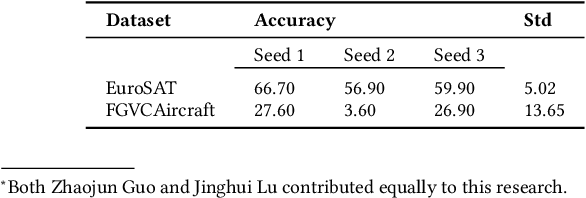

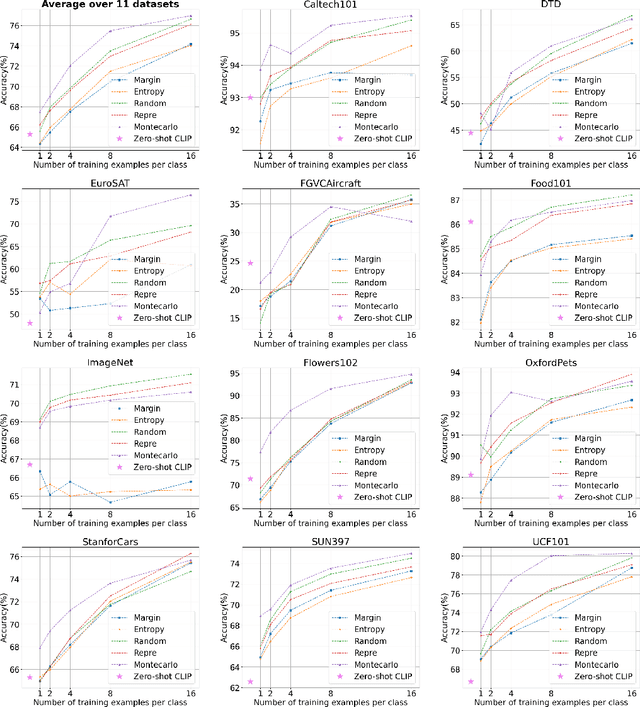
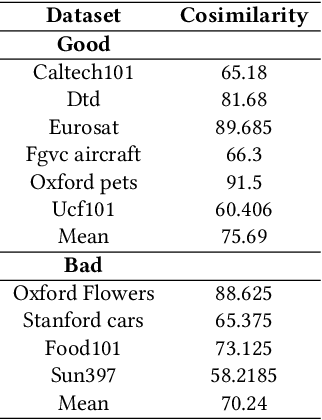
Abstract:Despite the notable advancements achieved by leveraging pre-trained vision-language (VL) models through few-shot tuning for downstream tasks, our detailed empirical study highlights a significant dependence of few-shot learning outcomes on the careful selection of training examples - a facet that has been previously overlooked in research. In this study, we delve into devising more effective strategies for the meticulous selection of few-shot training examples, as opposed to relying on random sampling, to enhance the potential of existing few-shot prompt learning methodologies. To achieve this, we assess the effectiveness of various Active Learning (AL) techniques for instance selection, such as Entropy and Margin of Confidence, within the context of few-shot training. Furthermore, we introduce two innovative selection methods - Representativeness (REPRE) and Gaussian Monte Carlo (Montecarlo) - designed to proactively pinpoint informative examples for labeling in relation to pre-trained VL models. Our findings demonstrate that both REPRE and Montecarlo significantly surpass both random selection and AL-based strategies in few-shot training scenarios. The research also underscores that these instance selection methods are model-agnostic, offering a versatile enhancement to a wide array of few-shot training methodologies.
MTVQA: Benchmarking Multilingual Text-Centric Visual Question Answering
May 20, 2024Abstract:Text-Centric Visual Question Answering (TEC-VQA) in its proper format not only facilitates human-machine interaction in text-centric visual environments but also serves as a de facto gold proxy to evaluate AI models in the domain of text-centric scene understanding. However, most TEC-VQA benchmarks have focused on high-resource languages like English and Chinese. Despite pioneering works to expand multilingual QA pairs in non-text-centric VQA datasets using translation engines, the translation-based protocol encounters a substantial ``Visual-textual misalignment'' problem when applied to TEC-VQA. Specifically, it prioritizes the text in question-answer pairs while disregarding the visual text present in images. Furthermore, it does not adequately tackle challenges related to nuanced meaning, contextual distortion, language bias, and question-type diversity. In this work, we address the task of multilingual TEC-VQA and provide a benchmark with high-quality human expert annotations in 9 diverse languages, called MTVQA. To our knowledge, MTVQA is the first multilingual TEC-VQA benchmark to provide human expert annotations for text-centric scenarios. Further, by evaluating several state-of-the-art Multimodal Large Language Models (MLLMs), including GPT-4V, on our MTVQA dataset, it is evident that there is still room for performance improvement, underscoring the value of our dataset. We hope this dataset will provide researchers with fresh perspectives and inspiration within the community. The MTVQA dataset will be available at https://huggingface.co/datasets/ByteDance/MTVQA.
Leveraging Large Language Models for Concept Graph Recovery and Question Answering in NLP Education
Feb 22, 2024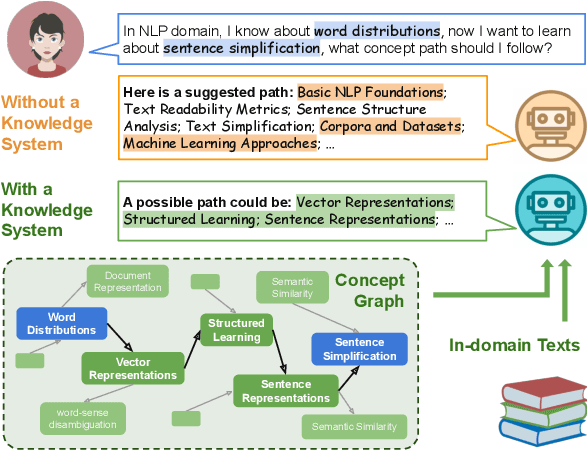
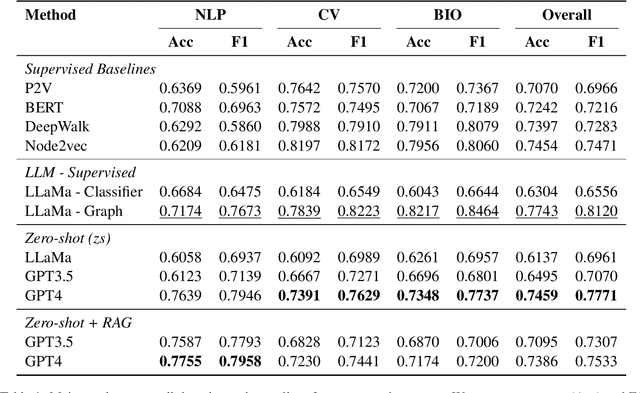


Abstract:In the domain of Natural Language Processing (NLP), Large Language Models (LLMs) have demonstrated promise in text-generation tasks. However, their educational applications, particularly for domain-specific queries, remain underexplored. This study investigates LLMs' capabilities in educational scenarios, focusing on concept graph recovery and question-answering (QA). We assess LLMs' zero-shot performance in creating domain-specific concept graphs and introduce TutorQA, a new expert-verified NLP-focused benchmark for scientific graph reasoning and QA. TutorQA consists of five tasks with 500 QA pairs. To tackle TutorQA queries, we present CGLLM, a pipeline integrating concept graphs with LLMs for answering diverse questions. Our results indicate that LLMs' zero-shot concept graph recovery is competitive with supervised methods, showing an average 3% F1 score improvement. In TutorQA tasks, LLMs achieve up to 26% F1 score enhancement. Moreover, human evaluation and analysis show that CGLLM generates answers with more fine-grained concepts.
PaDeLLM-NER: Parallel Decoding in Large Language Models for Named Entity Recognition
Feb 15, 2024
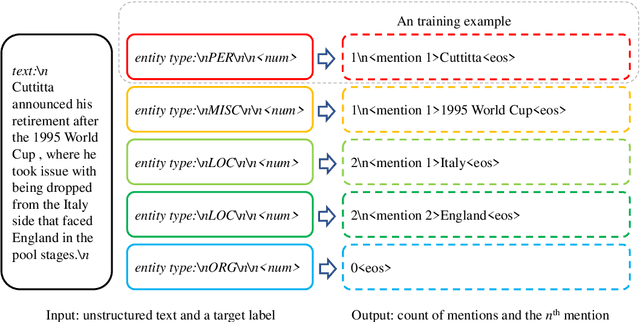
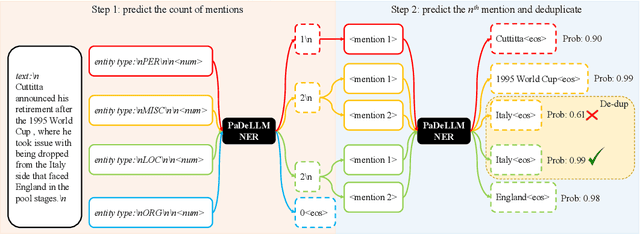

Abstract:In this study, we aim to reduce generation latency for Named Entity Recognition (NER) with Large Language Models (LLMs). The main cause of high latency in LLMs is the sequential decoding process, which autoregressively generates all labels and mentions for NER, significantly increase the sequence length. To this end, we introduce Parallel Decoding in LLM for NE} (PaDeLLM-NER), a approach that integrates seamlessly into existing generative model frameworks without necessitating additional modules or architectural modifications. PaDeLLM-NER allows for the simultaneous decoding of all mentions, thereby reducing generation latency. Experiments reveal that PaDeLLM-NER significantly increases inference speed that is 1.76 to 10.22 times faster than the autoregressive approach for both English and Chinese. Simultaneously it maintains the quality of predictions as evidenced by the performance that is on par with the state-of-the-art across various datasets.
 Add to Chrome
Add to Chrome Add to Firefox
Add to Firefox Add to Edge
Add to Edge